Discover Fatehpur Sikri: Mughal Marvels Unveiled
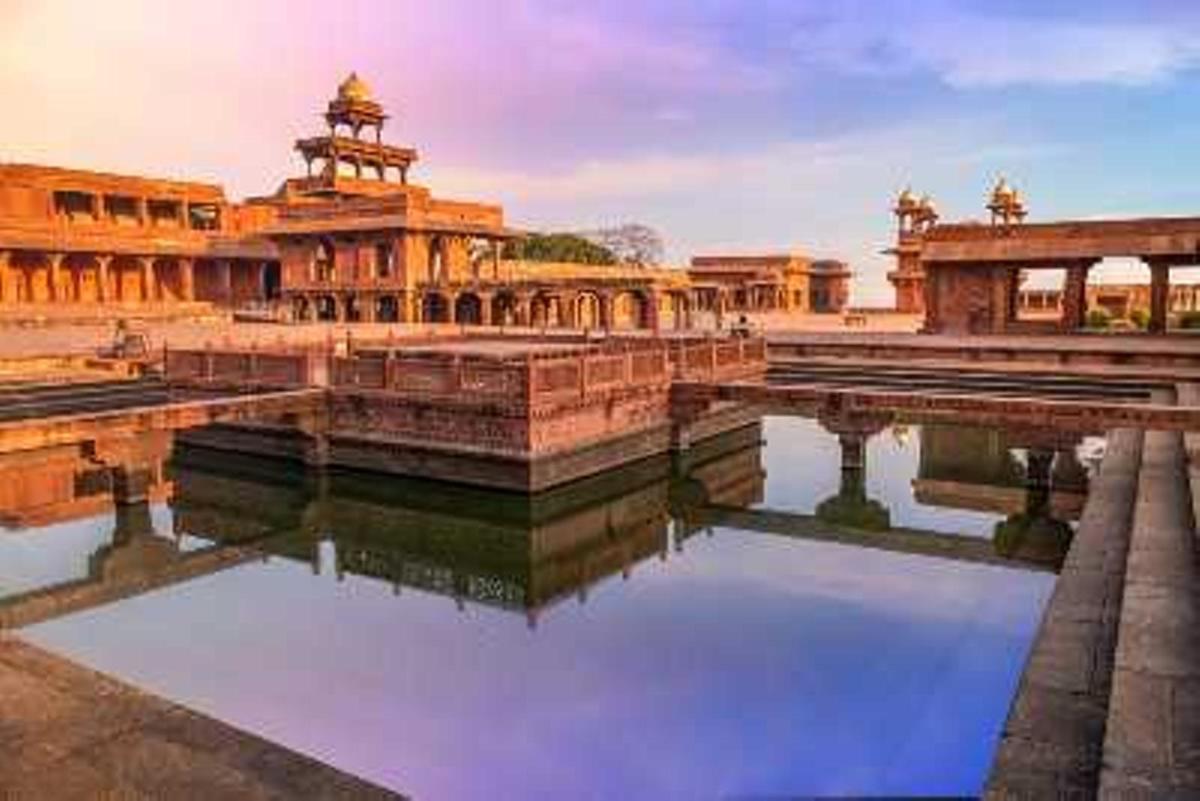
Introduction to Fatehpur Sikri
Fatehpur Sikri is a must-visit destination if you are a history enthusiast or a lover of architectural marvels. Located in the Agra district of Uttar Pradesh, India, this UNESCO World Heritage Site symbolises the grandeur of the Mughal Empire.
Historical significance of Fatehpur Sikri
Emperor Akbar built Fatehpur Sikri in the 16th century as his capital, but it was abandoned after just 15 years. Despite its short-lived existence, this city holds immense historical significance. It served as the political and administrative centre of the Mughal Empire and witnessed the reign of Emperor Akbar, who is known for his religious tolerance and administrative reforms.
Architecture and design of Fatehpur Sikri
The architecture and design of Fatehpur Sikri showcase a fusion of various styles, including Islamic, Hindu, and Persian influences. This amalgamation resulted in unique and exquisite structures reflecting the Mughal Empire's cultural diversity.
One of the most iconic structures in Fatehpur Sikri is the Buland Darwaza, also known as the Gate of Magnificence. Standing at a height of 54 meters, this grand entrance gate is adorned with intricate carvings and calligraphy, leaving visitors in awe of its majestic beauty.
Another notable attraction is the Jama Masjid, a stunning red sandstone mosque. The Jama Masjid's vast courtyard and intricately designed columns are a testament to the Mughal Empire's architectural prowess.
Fatehpur Sikri also houses several other magnificent structures, such as the Panch Mahal, Diwan-i-Khas, and Diwan-i-Aam, each with its unique design and purpose.
Visiting Fatehpur Sikri allows you to immerse yourself in the rich history and architectural brilliance of the Mughal Empire. It offers a glimpse into a bygone era and captivated visitors by its grandeur and beauty.
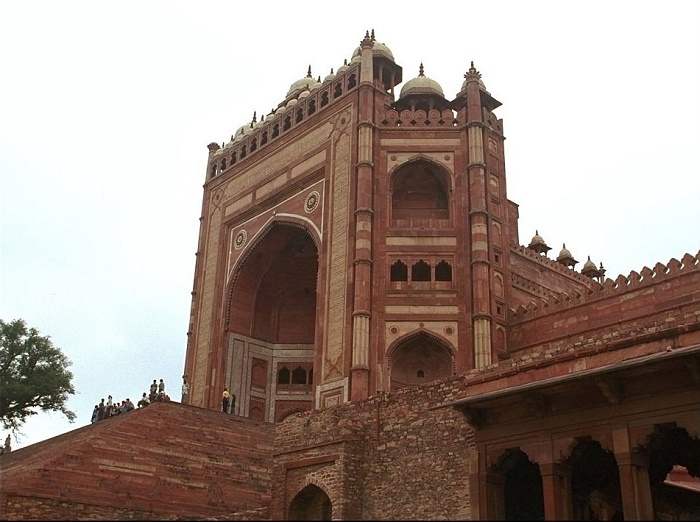
Buland Darwaza: The Grand Entrance
History and significance of Buland Darwaza
When you visit Fatehpur Sikri, one architectural marvel you cannot miss is the Buland Darwaza. This magnificent gate stands tall and proud, welcoming visitors to the Mughal city. Built by Emperor Akbar in 1575 to commemorate his victory over Gujarat, the Buland Darwaza holds great historical and cultural significance.
The word "Buland" means "high" or "magnificent" in Persian, and the gateway truly lives up to its name. It is considered the highest gateway in the world, with a height of 54 meters. The grandeur of the Buland Darwaza symbolizes the power and splendour of the Mughal Empire during its golden age.
Architectural features and intricate details
As you approach the Buland Darwaza, you will be mesmerized by its intricate architecture and exquisite details. The gateway is made entirely of red sandstone, adorned with ornate carvings and inlaid decorations. The imposing structure is topped with four tapering towers and a central dome, making it a sight to behold.
One of the most fascinating aspects of the Buland Darwaza is its calligraphy inscriptions. The gate is adorned with verses from the Quran, paying homage to Emperor Akbar's devotion to his religion. The intricate artwork and geometric patterns create a visually stunning effect, showcasing the artistry and craftsmanship of the Mughal era.
Visiting the Buland Darwaza is a sightseeing experience and a journey back in time. It gives you a glimpse into the grandeur and opulence of the Mughal Empire. As you step through the magnificent gate, let yourself be transported to an era of architectural marvels and cultural splendour.
Whether you are a history enthusiast or appreciate the beauty of extraordinary architecture, the Buland Darwaza is a must-visit destination that promises to leave you awe-inspired by the rich heritage of India.
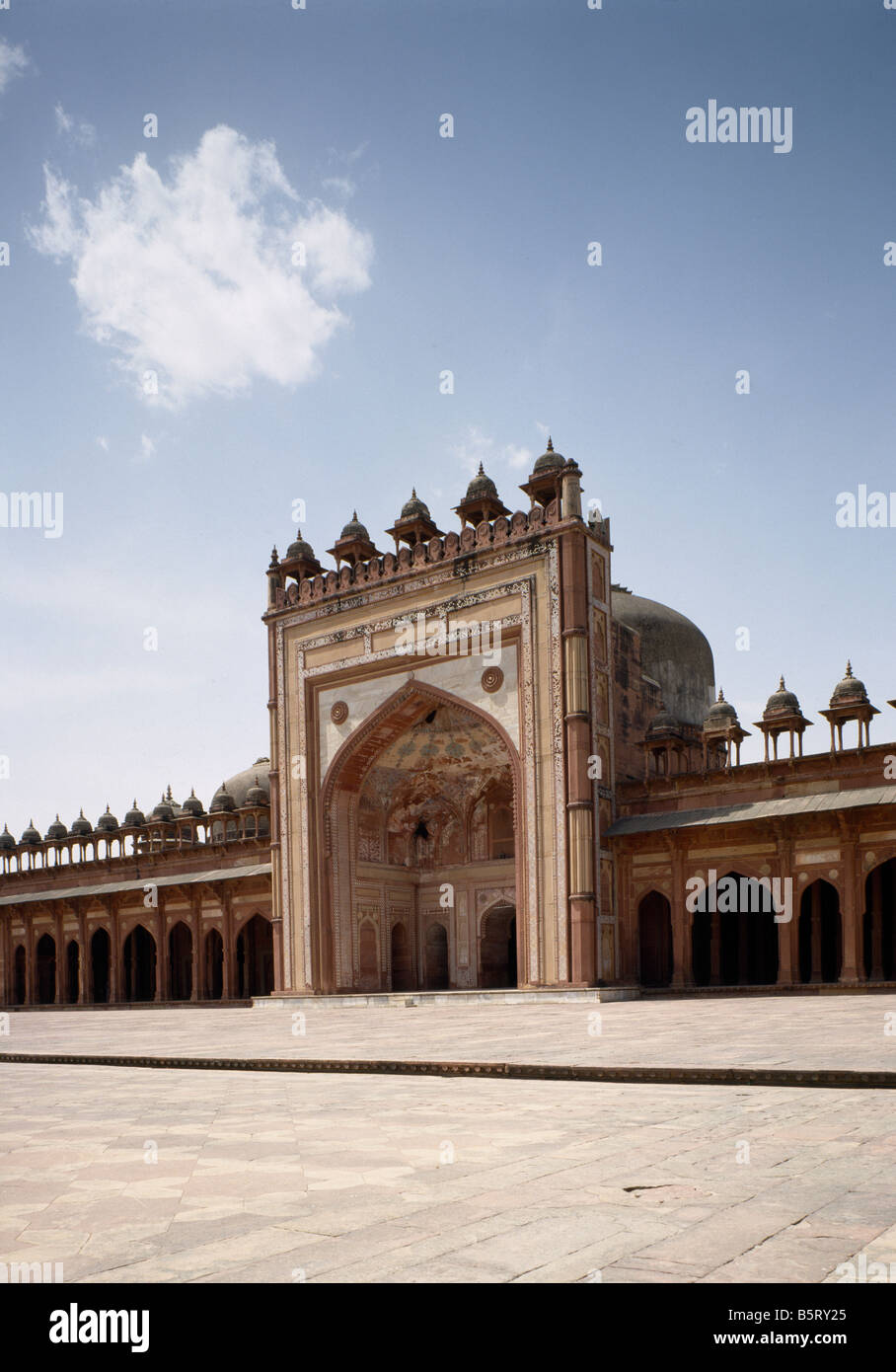
Jama Masjid: A Spiritual Haven
Overview of Jama Masjid
If you plan a trip to Fatehpur Sikri, visit the magnificent Jama Masjid. This historic mosque, built by Emperor Akbar in the late 16th century, is an architectural masterpiece and a testament to the Mughal era.
As you enter the premises, you will be captivated by the grandeur and peacefulness of the surroundings. The Jama Masjid is one of the largest mosques in India, with a capacity to accommodate thousands of worshippers. The imposing red sandstone structure stands tall, showcasing the skilled craftsmanship of the Mughal artisans.
Architectural highlights and decorative elements
The Jama Masjid is known for its intricate architectural details and decorative elements that adorn every corner of the mosque. The main entrance, the Buland Darwaza, is a magnificent gateway leading to the courtyard. It stands at an impressive height of 54 meters and is adorned with intricate carvings.
Inside the mosque is a spacious prayer hall with beautiful marble flooring and a mesmerizing geometric patterned ceiling. The central courtyard is surrounded by a colonnade with elegant pillars, creating a serene and peaceful atmosphere.
One of the most striking features of the Jama Masjid is the large and intricately designed mihrab, which indicates the direction of Mecca for Muslims during prayer. The mihrab is a masterpiece of Mughal architecture, with floral motifs and calligraphy adorning its surface.
As you explore the mosque, take a moment to appreciate the exquisite artwork and architectural brilliance that went into creating this spiritual haven.
A visit to the Jama Masjid in Fatehpur Sikri is necessary for anyone interested in Mughal history and architecture. Immerse yourself in the serene atmosphere, admire the intricate details, and soak in the spiritual essence of this marvellous monument.
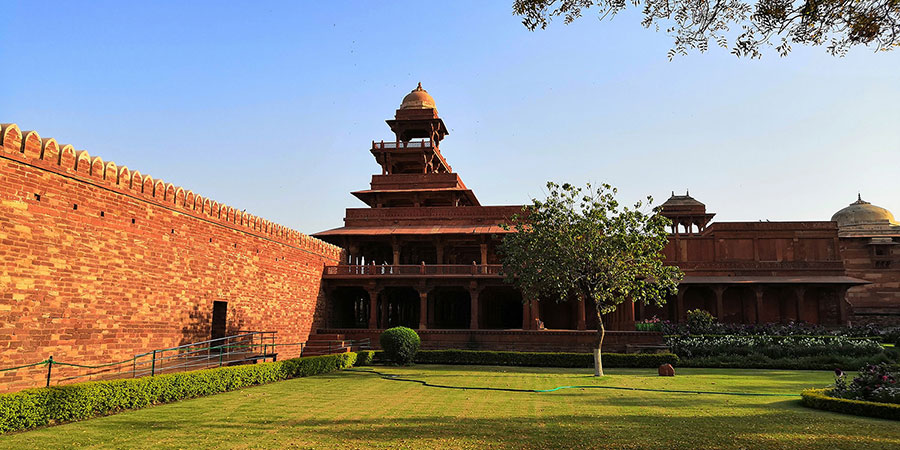
Panch Mahal: The Five Stories
Description of Panch Mahal
If you ever find yourself in Fatehpur Sikri, visit the magnificent Panch Mahal. This remarkable structure is a five-story palace that stands as a testament to the architectural brilliance of the Mughal Empire. Built by Emperor Akbar in the late 16th century, it was a retreat for the royal family and courtiers.
The Panch Mahal is an imposing structure with intricate latticework and delicate stone carvings. As you explore each floor, you'll be mesmerized by the beauty and grandeur of the palace. The ground floor has 84 massive stone pillars, while the upper floors gradually decrease in size, creating a visually stunning effect. From the top, you can enjoy a panoramic view of the surrounding area, including the stunning Buland Darwaza nearby.
Purpose and unique design features
The Panch Mahal was not just a residential palace; it served multiple purposes. The topmost floor was exclusively reserved for the emperor's harem, providing a secluded space for the royal women. The lower floors were used for social gatherings, musical performances, and discussions. The unique design of the palace allowed for good ventilation and created a cool breeze to combat the scorching heat of the summer.
One of the most intriguing design elements of the Panch Mahal is its distinct architectural style. Each floor has intricately carved pillars and ornate brackets, reflecting a fusion of Hindu and Islamic architectural influences. The open balconies provide a sense of openness and allow for beautiful views of the surrounding gardens.
As you explore the Panch Mahal, you'll feel transported back to the grandeur and opulence of the Mughal era. This architectural marvel is a must-see for anyone visiting Fatehpur Sikri, offering a glimpse into India's rich history and cultural heritage.
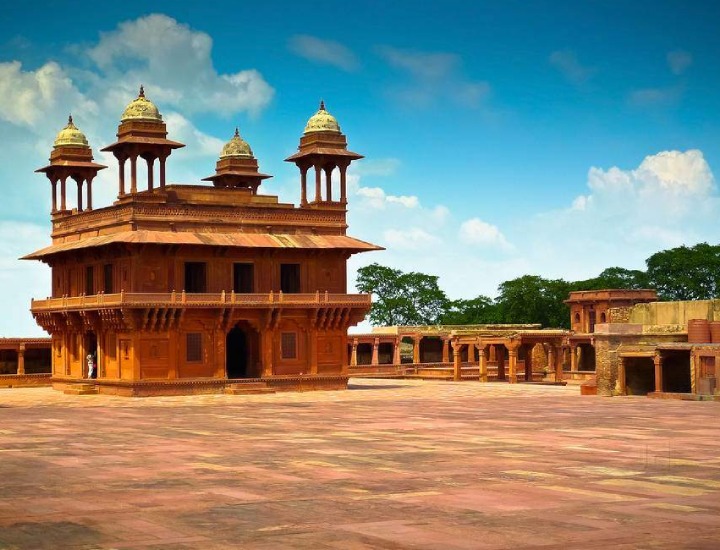
Diwan-i-Khas: The Hall of Private Audience
When you visit Fatehpur Sikri, one place you should not miss is the majestic Diwan-i-Khas, also known as the Hall of Private Audience.
History and significance of Diwan-i-Khas
Built-in the late 16th century by Emperor Akbar, this grand hall was constructed to hold private meetings and conferences with select courtiers and important guests. The Diwan-i-Khas was considered the epitome of architectural excellence and reflected Akbar's vision of a harmonious blend of Indian, Persian, and Islamic influences.
The hall holds great historical significance as it was where the emperor held discussions on matters of state, received important dignitaries, and discussed spiritual and philosophical matters with religious leaders. It was also here that religious debates were held in an atmosphere of tolerance and intellectual curiosity.
Layout and notable architectural elements
The Diwan-i-Khas is an architectural masterpiece with a unique layout and stunning design elements. The central area of the hall is adorned with a beautifully carved pillar known as the Hiran Minar, which served as the emperor's throne. The pillar is intricately decorated with intricate floral patterns and motifs.
The hall is surrounded by a colonnade of carved red sandstone columns, each exquisitely designed and adorned with intricate geometric and floral patterns. The columns support elegant arches, creating a sense of grandeur and beauty.
At the entrance of the Diwan-i-Khas, you will find an inscribed Persian verse that translates to "The world is a bridge, pass over it, but build no houses upon it." This verse reflects Akbar's philosophy of transience and the impermanence of worldly possessions.
Visiting the Diwan-i-Khas is a truly awe-inspiring experience, as it allows you to step back in time and witness the grandeur and architectural brilliance of the Mughal era.
Fatehpur Sikri's Diwan-i-Khas is a testament to India's rich history and cultural heritage and serves as a significant reminder of the Mughal Empire's legacy. So, be sure to explore this remarkable marvel and immerse yourself in the grandeur of the past.
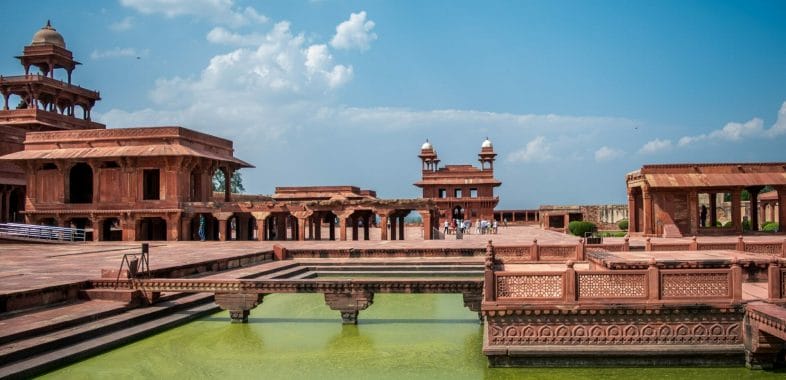
Introduction to the Tomb of Salim Chishti
Are you ready to explore the wonders of Fatehpur Sikri? One of the most captivating attractions within this historical city is the Tomb of Salim Chishti, a place that exudes reverence and spirituality.
Religious and historical importance
Step into the realm of Mughal marvels as you visit the Tomb of Salim Chishti. This sacred shrine holds immense religious significance and is revered by people from all walks of life. Built-in the 16th century, it is dedicated to the revered Sufi saint Salim Chishti, who was popular for his spiritual teachings and acts of kindness.
Many pilgrims and devotees visit the tomb yearly to seek blessings and pay their respects. The mystical aura of the place creates an atmosphere of peace and tranquillity, making it a favourite destination for those seeking solace and spiritual fulfilment.
Aside from its religious importance, the Tomb of Salim Chishti also has historical significance. It represents the grandeur and architectural brilliance of the Mughal era. The intricate marble lattice screens and decorative motifs are a testament to the exquisite craftsmanship of that time.
As you enter the tomb, you will discover the serene white marble structure adorned with delicate carvings. The tomb sits inside a courtyard adorned with beautiful arched gateways, reflecting the traditional Mughal architectural style.
The simplicity and elegance of the tomb, combined with its historical and religious significance, make it a must-visit attraction in Fatehpur Sikri. So, make sure to include the Tomb of Salim Chishti in your itinerary and experience this remarkable monument's spiritual and historical allure.
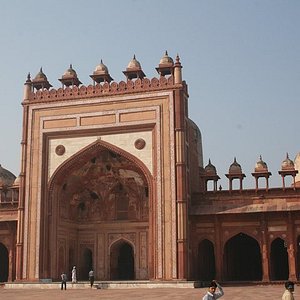
Palace of Jodha Bai: An Intricate Abode
Overview of the Palace of Jodha Bai
When you visit Fatehpur Sikri, one marvel that you cannot miss is the Palace of Jodha Bai. This magnificent structure is a testament to the grandeur of the Mughal era. Built by Emperor Akbar for his Hindu wife, Jodha Bai, the palace is a blend of Islamic and Hindu architectural styles.
The Palace of Jodha Bai is located in the northwest corner of the royal complex and is one of the largest buildings in Fatehpur Sikri. It boasts intricately carved sandstone walls, beautiful courtyards, and stunning geometric patterns that leave you in awe.
Architectural details and purpose
Step inside the Palace of Jodha Bai, and you will be transported to a time of opulence and splendour. The architecture of the palace reflects the fusion of Islamic and Hindu styles. The use of red sandstone, arched doorways, and elaborate brackets adds to the grandeur of the structure.
The palace is a multi-level structure with several rooms and courtyards. Each room is adorned with exquisite carvings and beautiful paintings. The spacious courtyards were used for various purposes, including gatherings and entertainment.
One of the most intriguing features of the Palace of Jodha Bai is its hidden passage. Legend has it that this secret passage connected the palace to the nearby Emperor's private quarters. The emperor used it to visit Jodha Bai without being noticed by the rest of the court.
Visiting the Palace of Jodha Bai is like stepping into a world of intricate beauty. The blend of styles and the attention to detail make this palace a must-see attraction in Fatehpur Sikri.

Tips for visiting and exploring the Mughal marvels
-
Plan your visit: Before visiting Fatehpur Sikri, check the opening hours and plan your day accordingly. It's best to arrive early to avoid crowds and maximise your time exploring the site.
-
Guided tours: Consider opting for a guided tour to appreciate each structure's history and significance fully. An expert guide can share fascinating stories and insights to enhance your experience.
-
Comfortable footwear: Exploring Fatehpur Sikri involves a lot of walking, so wear comfortable shoes to ensure a pleasant visit. The site is spread over a vast area; you wouldn't want sore feet to dampen your experience.
-
Respect the monuments: As you explore the Mughal marvels, remember to show respect for the site's historical significance. Avoid touching or climbing on the structures and follow any guidelines or signs provided.
-
Capture the memories: Don't forget your camera! Fatehpur Sikri offers countless photo opportunities. From the intricate carvings to the breathtaking views, you'll want to capture every moment to cherish and share.
Fatehpur Sikri is a testament to the grandeur and opulence of the Mughal era. By following these tips, you can make the most of your visit and truly appreciate the beauty and history that unfolds at every corner of this magical place. So, lace up your shoes, grab your camera, and prepare for an unforgettable journey into the world of Mughal marvels at Fatehpur Sikri!
